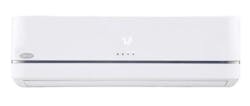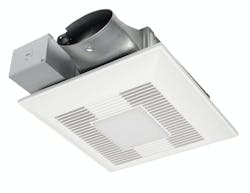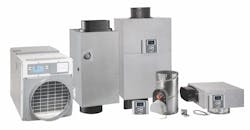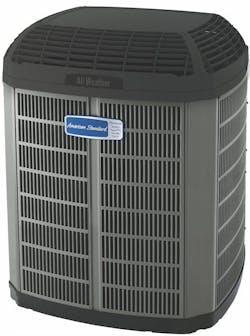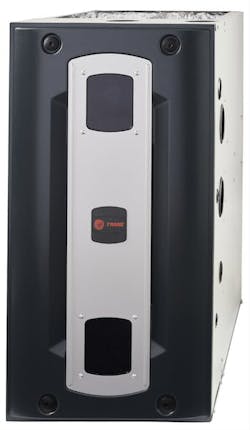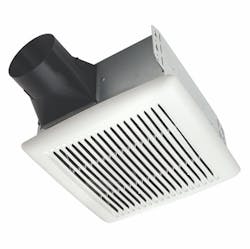There was a time when, for a variety of reasons—poor insulation, leaky windows, pitiful air sealing—most homes were inefficient. And, in some respects, that inefficiency wasn’t always a bad thing. The fact that these leaky houses were far from airtight meant stale air had a way to exit the building while fresh air entered, and these older homes were able to dry out when they got wet, which explains why really old homes rarely have mold damage or rotten wood—discoloration yes, but hardly ever any rotting.
But that isn’t the ideal way to build a house. You have to insulate, air seal, and ventilate.
HVAC is one of the most important systems in homes today, not least because heating and cooling constitutes the largest energy expense for most homeowners, accounting for more than half of the energy use in a typical U.S. home, according to the Department of Energy, but also because there's a growing awareness of the importance of indoor air quality, since most Americans spend a significant amount of their time indoors, whether it's at home or in the office or other buildings, where gases, chemicals, and various particulate pollutants can cause allergies, headaches, eye irritation, fatigue, and other health issues. And now there is the additional concern of air quality as it relates to COVID-19.
More Efficient HVAC to Reduce Energy Consumption
One way builders can help homeowners reduce energy consumption is by switching to high-efficiency HVAC units. New standards for central air conditioners took effect on Jan. 1, 2015, raising the SEER (seasonal energy efficiency ratio) to 13 or 14 in most parts of the country. The DOE also has proposed even more stringent standards, which would take effect in 2023 if the regulation is approved. However, as a general practice, it’s a good idea to go above the minimum whenever possible.
Bath fans and range hoods should also be considered when it comes to proper ventilation. For most existing homes, exhaust systems are effective at removing stale air, pollution, or moisture from a house. But in new homes that are well insulated and properly air sealed, a balanced ventilation system removes stale air and brings fresh air in from outside.
Some building scientists recommend an Energy Star-rated bathroom fan or range hood that’s also rated for quiet, continuous operation to accomplish this goal. The fans run at a low level all of the time and then run at a higher level when needed. It’s recommended that installers calibrate and set the continuous fan speeds based on the number of occupants or bedrooms and on how tightly a home has been sealed. These considerations will ensure the fans remove indoor air pollutants and maintain the right amount of humidity.
If these systems are well designed and correctly installed, your buyers will have homes that not only maintain fresh air, but will be free of mold and premature rot for many years to come.
RELATED
- Getting HVAC Right: Consider These Tips When Sizing and Specifying
- Bring HVAC Ducts Inside
- 7 Tips for Accurate HVAC Load Calculations
- Net Zero Energy: The Ultimate Z.E.N. Home's Indoor Air Quality System
HVAC Products
Ductless System From Carrier
One of the brand’s ductless systems, the Performance Series high wall unit from Carrier offers the ideal balance between budget and energy savings, the brand says. The 40MAQ can be paired with the 38MAR heat pump as part of a single-zone system or with the 38MGR heat pump for multiple zones. It has four indoor fan speeds, a sleep mode, and operates at a decibel levels as low as 27 dB. It comes with a wireless remote controller or an optional wired controller.
Low-Profile Ventilation Fan From Panasonic
Panasonic says its WhisperValue DC motor ventilation fan is the lowest-profile Energy Star–rated ventilation fan available. Offering multiple speeds—80 CFM to 100 CFM—to satisfy ASHRAE 62.2 compliance, it features: an electronically commutated motor with SmartFlow technology, which moves more air using less energy, to produce the optimum CFM output; a 3 3/8-inch profile to fit virtually anywhere; and a 10-watt, dimmable LED chip panel.
Bath Fans by Fantech
The Pro Plus Series collection of bath fans from Fantech offers a brushless DC motor, sound levels as low as 0.3 sones, and onboard speed control that delivers 80 CFM to 140 CFM. Fans may also include humidity and motion sensors, automatic shut-off, and LED lighting. Products also come with a backdraft damper and 6-inch duct connection.
Even Cooling Technology From Samsung
Samsung says its Wind-Free Cooling one-way indoor cassette uses thousands of micro holes to distribute air throughout the space without blowing directly on occupants. Homeowners can activate Wind-Free cooling by pressing the controller’s Wind-Free button; Smart Cooling mode cools air quickly and efficiently, using Fast Cooling at first, and then automatically switching to Wind-Free mode when the room nears the set temperature, the company says. Five capacities are available.
Ductless HVAC From Mitsubishi Electric
Part of a ductless HVAC system, the Mitsubishi Electric MLZ is a one-way ceiling cassette that features the brand’s EZ Fit design so the recessed ceiling cassette can be mounted between standard 16-inch joists, making it an ideal heat pump for retrofits or new-construction applications, the company says. Offered in three models, each unit has a five-speed fan motor that can be adjusted to deliver optimal airflow for any application.
Whole-Home Ventilation System From Aprilaire
Aprilaire’s Model 8126X is a whole-home ventilation system that helps buyers control the air freshness in every room, expelling stale, stagnant air and replacing it with fresh, clean air. The system, the manufacturer says, greatly reduces moisture problems, odors, and indoor pollutants, such as radon and VOCs. The controller decides when and how long to ventilate based on its continuous monitoring of indoor relative humidity, outdoor temperature, and user-friendly settings.
Quiet HVAC From American Standard
The AccuComfort Platinum Series 18 is American Standard’s quietest air conditioner, the manufacturer says. A variable-speed motor and AccuComfort technology allow the system to adjust more efficiently. The Platinum Series offers up to 18.00 SEER, enhanced humidity control, and low compressor modulation and fan speeds that ensure low noise levels. It comes in five models from 2 tons to 5 tons.
Efficient Gas Furnace From Trane
Trane says the S9V2-VS gas furnace includes features to maximize home efficiency in both heating and cooling seasons. During the winter, the unit is rated at 97% efficiency, meaning it uses less gas to heat a home than comparable less-efficient models. During the summer months, a variable-speed Vortica II blower uses less electricity, meaning higher efficiency for the home, and the Comfort-R enhanced dehumidification mode reduces home humidity.
Easy-to-Install Exhaust Fan From Broan
The Broan Flex Series 80 CFM exhaust fan can be installed room-side, eliminating the need for attic access. The fan features foldable mounting ears and an EzDuct connector for fast, simple installation and comes with a new duct damper that provides a tighter seal, resulting in reduced backdrafts, the company says. Rated for use over a tub or shower, the exhaust fan has bright white grilles to match most ceiling paint and operates at just 1.5 sones.

